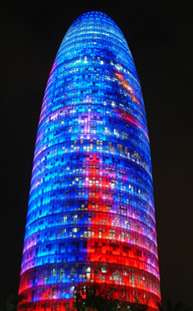Architecture or sculpture?
ARCHITECTURE or SCULPTURE? A brief essay about the thin line dividing architecture and sculpture, and how those concepts are being confused
by theartwolf.com
Look at the two pictures below: they depict two contemporary, well-known and generally admired three-dimensional artworks. The first of them is a work by an architect. The second one, a work by a sculptor. However, does it mean that the first one is unquestionably an architectural work? Or would it be more correct to consider that we are looking at a large sculpture “disguised” as architecture? Personally, I would incline to accept this second option, basing this idea on a series of reasons that I will develop in this essay.


Top: Frank Gehry – Richard B. Fisher Center at the Bard College (2004) (photo by Paul Masck) Bottom: Richard Serra – “Fulcrum” (1987), steel installation in Liverpool
In his essential book “Introduzione all’architettura”, Bruno Zevi, one of the most important Architectural critics of the 20th century, points, when talking about to the Parthenon: “Those who investigate the Greek temple in an architectonical way, looking only for a space conception, will have to flee horrified, considering it as a typical example of non-architecture. But those who approach to the Parthenon and contemplate it as a great sculpture will consider it one the best works ever created by the human genius”. Saving the obvious distances, this affirmation would be suitable for some of the most celebrated architectures of nowadays.
What is Architecture, after all? Is it possible to find an exact definition that allows us to trace a dividing line between what we can consider Architecture and what no? It is very probable that that is not the case, as no precise definition exist for the concept of “Art”, or even for the concept of “Love”. But it is possible, for example, to distinguish between what is Architecture and what is just construction. Nobody doubts, for example, that a Gothic chapel or a Venetian palace is an excellent and unquestionable example of architecture, whereas a very large fuel tank (of similar dimensions) does not deserve such consideration. In the same way, it is also possible to find values that allow us to distinguish between what is Architecture, and what is -voluntarily or not- a sculpture of huge dimensions.

Richard Serra – “Torqued ellipses ” (1997), corten still installation in New York
Almost all the Architecture critics from the last two centuries agree on the idea of pointing to the interior space as the defining factor in Architecture. When considering the Parthenon as a not-architecture, Zevi points out that the Greek temple was conceived to be admired from the outside, as a glorious and impenetrable object, admirable by its harmony, proportions and rich decoration. This appreciation is applicable to many works of nowadays, modern formal temples; in which the interior space – which of course exists, and can be even well designed- is pushed into the background.
This interior space must be, of course, dedicated to a sole protagonist: the human being. The human scale, the adjustment of distances and proportions to the necessities and capacities of the residents/users/visitors, the flexibility of use. Thus, that a work supposes a remarkable spatial experience for the user or visitor is not sufficient to consider it as Architecture: many installations by Richard Serra form a spatial experience immensely richer than most of contemporary buildings. But this is, in any case, a sculptural, not architectonic space.

Frank Gehry – Disney Hall (2003) Photo by Aaron Logan
But the prominence of the interior space is not the sole characteristic of the Architecture. All architectonic work, from an “existenzminimun” to an imposing State Museum , is not an isolated object; on the contrary, it has to adapt to the environment -human and constructed- in which it is inserted. This idea, accepted almost as an obvious one by all the great Architecture critics of modern times, from William Morris to Aldo Rossi; is nowadays being questioned -perhaps not always explicitly- by many of the most famous contemporary architects. Only thus we can understand that an architectonical superstar as Frank Gehry proposes a practically identical solution for projects in Bilbao, Los Angeles or Great Britain.
Architecture, sculpture… Perhaps, at heart, this subject is not more than pure semantics, but in any case I would like to express my opinions about it. And I will feel very disappointed if this little essay is understood as an attack to certain “architects” of nowadays. Returning -once again- to Zevi: “The Parthenon is a non-architectonic work, but in any case is still an Art masterpiece”.
Follow us on:


